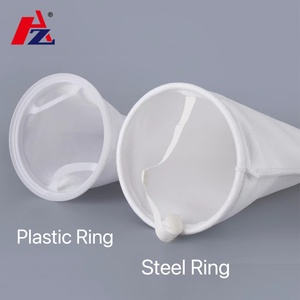
All categories
Featured selections
Trade Assurance
Buyer Central
Help Center
Get the app
Become a supplier

(7213 products available)



























Generally, filter meshes are categorized based on types of materials used to manufacture them. This, of course, goes hand in hand with their respective applications. Here are some common types of three micron filter mesh;
The 3 micron filter mesh specifications vary depending on its intended use. These include the dimensions, material, mesh count, and micron size.
In addition to the above, it is important to note that 3 micron filter meshes are also available with varying hole shapes and sizes. For example, round holes are predominantly used in water treatment industries to remove water contaminants. Oblong holes are used in the food and beverage industry for fruit juices and wine filtration applications.
Although the three-micron filter mesh is sturdy and durable, it still requires regular cleaning and maintenance. As a result, it provides consistent and reliable filtration. Here are some cleaning and maintenance tips:
It is important to periodically inspect the filter for any damaged areas, including tears and clogs. If found, then the filter must be repaired or replaced immediately. With these simple maintenance tips, the 3 micron filter mesh will be able to provide many years of service!
Food and beverage industry
In the food and beverage sector, 3 micron filter meshes are frequently utilized in the brewing, juice extraction, and dairy processing enterprises, among other areas; to separate undesirable components and guarantee product purity and quality.
Pharmaceuticals and biotechnology industry
In the pharmaceuticals and biotechnology industries, 3 micron filter meshes are frequently utilized for cell separation, drug purification, and liquid filtration, and so forth. They assist in making certain the purity and efficacy of medicines and enhance the safety and reliability of bioprocesses.
Water treatment and environmental protection
In the area of water treatment and environmental protection, 3-micron filter meshes are extensively used in areas such as waste water therapy, sewage filtration, and water purification. They assist in eliminating contaminants, particulate matter, and harmful substances from water, ensuring the quality and safety of treated water.
Chemical and polymer manufacturing
In chemical and polymer manufacturing, 3-micron filter meshes are commonly used in processes such as liquid filtration, resin separation, and polymer extrusion. They help remove impurities, undissolved particles, and agglomerates from the production process to ensure product quality and process stability.
Industrial manufacturing and processing
In industrial manufacturing and processing, 3-micron filter meshes find applications in fields such as petrochemical, metallurgy, and machinery. They are used for fluid filtration, slag removal, and material separation, playing a vital role in ensuring equipment operation, product quality, and production efficiency.
When selecting a 3 micron filter mesh, several factors should be considered.
Application Needs:
Industrial filter production, the application demands selecting the right filter mesh material, aperture size, compatibility, and performance to meet the specific needs of the application.
Quality:
The mesh integrity, evenness, non-defective, uniform aperture, consistent wire diameter, weave accuracy, low leakage, nylon filter mesh low quality, high performance, products, and poor filtration will not effectively remove contaminants, and some will remain in the liquid.
Qty:
When placing an order for a 3-micron filter mesh, it is important to consider the quantity. Three-micron filter mesh is a fabric material that strains contaminants measuring three microns or larger, and nylon is an ideal mesh material. Depending on the filtration application, purchasers should order an adequate number of filters. More extensive quantities usually lead to a lower price per filter.
Sizes:
The mesh comes in various sizes, either flat, single layer, double layer, or in pockets, to meet diverse needs.
Coating:
Three-micron filter mesh can have coatings. For example, PVC coatings increase filter durability by making them abrasion-resistant, while hydrophobic coatings prevent water from passing through but allow air filtration. Choosing a 3-micron filter mesh with the proper coating can help prolong the filter's life.
Q1: What does 3 micron filter mesh mean?
A1: The term mesh size is used to describe the number of holes in a filter screen per linear inch. When discussing mesh size, people often refer to the size of holes and what is filtered. For example, the 3 micron filter mesh size has three million holes in every square inch. The 3 micron filter mesh size means that particles that are 3 microns or larger can get through the filter.
Q2: Is mesh size the same as micron size?
A2: No, mesh size is not the same as micron size. Micron is the measurement of a filter's hole size, while mesh is the number of holes in the filter per square inch.
Q3: Why is mesh size important?
A3: Knowing mesh sizes is important because it helps people understand what the filter can capture. For instance, using 100 mesh stainless steel filter will allow sand to pass through, but it will catch salt.
Q4: What is the difference between mesh and micron?
A4: The number of holes in a filter mesh screen is referred to as "mesh," while "micron" refers to the filter screen hole size. Mica is a term used to describe a measurement that is one-millionth of a meter. The human hair is about 70 microns, and people can see it with the naked eye. Water bacteria range from 1 to 5 microns, and viruses are even smaller, at about 0.1 microns.
Q5: What is filter mesh used for?
A5: Industrial stainless steel filter mesh can separate, retain, convey, and exhaust gas, liquid, and solid materials in pipelines. It is widely used in chemical fiber, petroleum, chemical, metallurgy, light industry, food, medicine, machinery, automotive, nuclear power, and other industries.